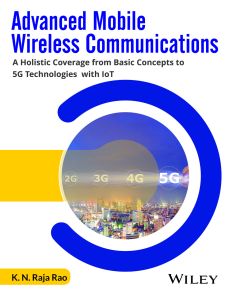Advanced Mobile Wireless Communications: A Holistic Coverage from Basic Concepts to 5G Technologies with IoT
ISBN: 9789357460637
352 pages
For more information write to us at: acadmktg@wiley.com

Description
5G, the dawn of a new era, is an emerging technology that will transform communication and take it to new heights. It would cater not only to human-to-human communication but also to device-to-device, human-to-device and machine-to-machine communication. Spanning over 9 chapters, this book intends to give an in-depth analysis of the 5G technologies with IoT. From the basic concepts of cellular communication to the challenges of 5G, the book covers all the key ideas of the technologies developed for 5G.
Chapter 1 Basics of Cellular Communication
1.1 Mobile Cellular Communication
1.2 Technologies Used in Wireless Communication
1.3 General Architecture of Cellular Communication
1.4 Cells and Cell Capacity
1.5 Mobility Management in Cellular Networks
1.6 Various Handoff Techniques
1.7 Location Update Procedure
1.8 Channel Allocation Strategies
1.9 Power Control Strategies
1.10 Frequency Planning in Cellular Communication
1.11 Fading Channels and Models
1.12 What We Learnt in This Chapter
Chapter 2 Review of Various Generations of Cellular Communication: 2G to 5G
2.1 Background
2.2 2G Technology
2.3 3G: The Third Generation
2.4 Spectrum Utilisation in WCDMA and TD CDMA
2.4.1 3G Architecture
2.5 Fourth Generation (4G)
2.6 Fifth Generation (5G)
2.7 Sixth Generation (6G) and Beyond
2.8 What We Learnt in This Chapter
Chapter 3 Long-Term Evolution and 4G
3.1 Evolution of LTE
3.2 Building Blocks of LTE
3.3 Bandwidth Enhancement in LTE
3.4 MIMO and Beamforming
3.5 All-IP Core Network – VoLTE
3.6 LTE-Advanced
3.7 Looking Forward
3.8 What We Learnt in This Chapter
Chapter 4 5G Unfolded
4.1 3GPP Goals for 5G
4.2 5G Entities
4.3 Interaction of UE in 5G
4.4 Radio Communication Aspects in 5G Network
4.5 OFDM Numerologies for NR
4.6 5G Frequency Spectra
4.7 5G Services
4.8 5G in Various Applications
4.9 What We Learnt in This Chapter
Chapter 5 5G System Architecture and Network Features
5.1 3GPP Work Group and Release 15
5.2 5G Architecture
5.3 Centralised and Distributed RAN
5.4 Dual Connectivity in 5G
5.5 5G Service-Oriented Architecture
5.6 LTE Functional Split
5.7 Network Slicing
5.8 Heterogeneous Network in 5G
5.9 Artificial Intelligence and Machine Learning in 5G
5.10 What We Learnt in This Chapter
Chapter 6 New Technologies in 5G
6.1 Virtualisation in 5G Network
6.2 Distributed Mobile Network Architecture
6.3 Multi-RAT Interworking
6.4 Multi-Tenancy
6.5 Mobile Edge Computing
6.6 Multiple Access through Massive MIMO
6.7 Device-to-Device (D2D) Communications
6.8 New Radio Frequencies and Radio Convergence
6.9 Channel Coding
6.10 What We Learnt in This Chapter
Chapter 7 5G Functional Layers in Virtual Environment
7.1 ETSI-Proposed Architecture
7.2 Network Data Layer
7.3 Control Plane
7.4 User Plane
7.5 Management and Orchestration Layer
7.6 Open-Source MANO for 5G
7.7 SDN and NFV
7.8 Network Overlay
7.9 What We Learnt in This Chapter
Chapter 8 5G Use Cases and IoT Applications
8.1 5G as an Enabler for IoT and mIOT
8.2 5G Applications in Different Verticals
8.3 Health Care
8.4 Intelligent Transport Systems
8.5 Industrial Automation
8.6 Smart Logistics
8.7 Positioning
8.8 Smart City
8.9 What We Learnt in This Chapter
Chapter 9 Beyond 5G
9.1 Challenges in 5G
9.2 Releases 16 and 17, and Beyond Release 17
9.3 New Emerging Standards and 6G
9.4 What We Learnt in This Chapter
Exercises
Bibliography
Index

